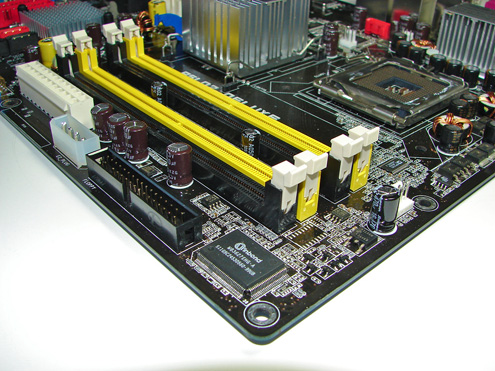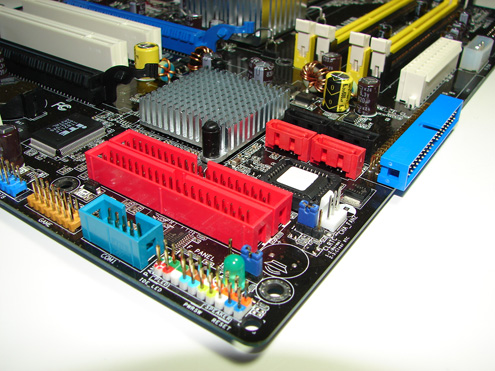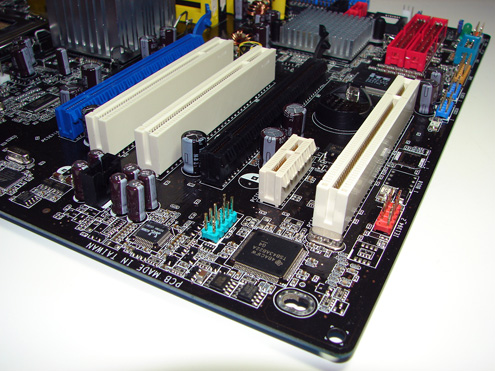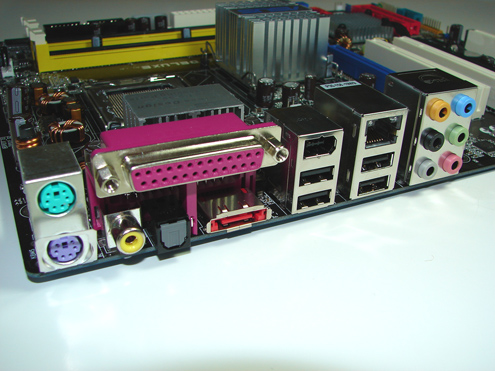Intel 945P Motherboards: Going from Hopeless to Enthusiastic
by Gary Key on November 15, 2005 12:02 AM EST- Posted in
- Motherboards
ASUS P5LD2 Deluxe: Features
Asus designed a generally well laid out board with all major connections easily reached. The board is lacking most clearance issues and was very easy to install in a mid-size ATX case. Asus did an excellent job with the color coordination of the various peripheral slots and connectors.
The Intel SATA II ports are conveniently located below the ICH7R chipset and above the primary IDE connector. The SATA II ports feature the new clamp and latch design. Asus did not include the new cable designs in their accessory kit, which greatly enhance the security of the SATA connections.
The ITE 8211F IDE port connectors are located to the left of BIOS chip and could create cable clutter in certain case designs and could hinder access to the Intel SATA II ports.
The Intel USB connectors, IEEE1394a connector, and Com1 serial port are located along the left edge of the board and are a tight fit when utilizing the bottom PCI slot. The CMOS reset is a traditional jumper design located next to the BIOS chip and below the ITE 8211F IDE port connectors that proved to be inconvenient at times.
However, in between the two x16 PCI Express slots are two 32bit PCI slots. This configuration could potentially render the first 32bit PCI slot useless when utilizing the first x16 PCI Express slot. We did not have any issues utilizing this slot with video cards containing single slot cooling systems, but we were unable to install a sound or network card upon installation of a NVIDIA 6800 Ultra in the x16 PCI Express slot.
The Northbridge and Southbridge chipsets are passively cooled with large heatsinks that do not interfere with any installed peripherals. In fact, this system kept the chipsets cool enough that additional chipset voltage was not a factor in our overclocking tests. Asus places the eight-pin 12V auxiliary power connector at the top of the CPU socket area, but out of the way of most aftermarket cooling solutions.
The only oddity in the area is the red Silicon Image 3132 SATA II connector located right below the I/O panel. The location of this connector is not ideal, but is required due to the second Silicon Image 3132 SATA II connector being located on the back I/O panel.
The BIOS options are abundant on the P5LD2 Deluxe, with memory voltage to 2.3V, and an extensive range of chipset, bus, and vCore voltage adjustments. Memory ratios are limited compared to the nForce4 Intel Edition boards, but Asus did manage to offer more settings than the other two Intel 945P boards that were reviewed. The board fully supports manual memory timing adjustments or allows for an Auto setting that will set the memory to the SPD settings. This Auto setting will adjust the memory timing settings automatically when the system is overclocked. You have the ability to overclock the system utilizing the AI Overclock profiles that have preset percentages or to use the AI N.O.S. feature that will overclock the system dynamically based upon system loads.

Asus designed a generally well laid out board with all major connections easily reached. The board is lacking most clearance issues and was very easy to install in a mid-size ATX case. Asus did an excellent job with the color coordination of the various peripheral slots and connectors.


The Intel SATA II ports are conveniently located below the ICH7R chipset and above the primary IDE connector. The SATA II ports feature the new clamp and latch design. Asus did not include the new cable designs in their accessory kit, which greatly enhance the security of the SATA connections.
The ITE 8211F IDE port connectors are located to the left of BIOS chip and could create cable clutter in certain case designs and could hinder access to the Intel SATA II ports.
The Intel USB connectors, IEEE1394a connector, and Com1 serial port are located along the left edge of the board and are a tight fit when utilizing the bottom PCI slot. The CMOS reset is a traditional jumper design located next to the BIOS chip and below the ITE 8211F IDE port connectors that proved to be inconvenient at times.

However, in between the two x16 PCI Express slots are two 32bit PCI slots. This configuration could potentially render the first 32bit PCI slot useless when utilizing the first x16 PCI Express slot. We did not have any issues utilizing this slot with video cards containing single slot cooling systems, but we were unable to install a sound or network card upon installation of a NVIDIA 6800 Ultra in the x16 PCI Express slot.

The Northbridge and Southbridge chipsets are passively cooled with large heatsinks that do not interfere with any installed peripherals. In fact, this system kept the chipsets cool enough that additional chipset voltage was not a factor in our overclocking tests. Asus places the eight-pin 12V auxiliary power connector at the top of the CPU socket area, but out of the way of most aftermarket cooling solutions.
The only oddity in the area is the red Silicon Image 3132 SATA II connector located right below the I/O panel. The location of this connector is not ideal, but is required due to the second Silicon Image 3132 SATA II connector being located on the back I/O panel.


The BIOS options are abundant on the P5LD2 Deluxe, with memory voltage to 2.3V, and an extensive range of chipset, bus, and vCore voltage adjustments. Memory ratios are limited compared to the nForce4 Intel Edition boards, but Asus did manage to offer more settings than the other two Intel 945P boards that were reviewed. The board fully supports manual memory timing adjustments or allows for an Auto setting that will set the memory to the SPD settings. This Auto setting will adjust the memory timing settings automatically when the system is overclocked. You have the ability to overclock the system utilizing the AI Overclock profiles that have preset percentages or to use the AI N.O.S. feature that will overclock the system dynamically based upon system loads.










26 Comments
View All Comments
Houdani - Tuesday, November 15, 2005 - link
The other reviewers here at Anandtech offer their own style, thereby providing the "mix it up" factor. I personally don't think you need to adjust your style, as I happen to like the cultural infusion supplied by your literary quotes.Furen - Tuesday, November 15, 2005 - link
Fair enough, I was just giving my personal opinion on the matter.bersl2 - Tuesday, November 15, 2005 - link
What's wrong with being exposed to what the author believes to be wisdom? Surely you don't read these articles simply for the technical specifications; otherwise, you would read the spec sheet. Why, then, do you object to the author trying to relate an idea to you?Furen - Tuesday, November 15, 2005 - link
I read the articles for their technical merits. Spec sheets do not show how the different components interact with one another nor can they show performance, stability, etc; and, most importantly of all, they're made by the manufacturer, who is hardly to be considered an unbiased source. The problem with throwing a strong idea in front of the reader before giving him article is that this idea becomes the filter through which the rest of the article is viewed. This is, of course, very effective if you are trying to persuade the user to reach the same conclusions as you, but it skews the reader's ability to analize the purely technical merits of the products.mbhame - Tuesday, November 15, 2005 - link
What makes you so sure Conroe is the last P4? ;)JarredWalton - Tuesday, November 15, 2005 - link
Conroe isn't a P4. It's the next generation architecture that Intel has not yet named - also referred to as the NGATIHNYN. :p